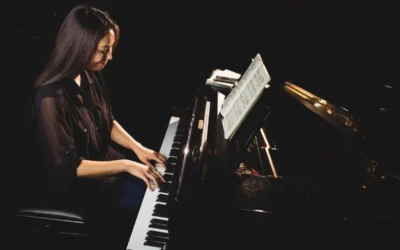
3/4 vs 6/8 time: What is the difference?
The difference between 3/4 and 6/8 is a FAQ amongst our students. Let’s see why they are so different in writing and musically.
What do 3/4 and 6/8 mean?
As always, time signatures will give us all the information we need to measure music in time.
The numbers tell us how many beats we have in a bar and what kind of beats they are.
Let’s have a look at how can we work this out.
So basically, we have got two numbers in any time signature.
The upper number tells us how many of something there are in a bar.
In a 3/4, there will be 3 somethings in each bar.
In a 6/8, there will be 6 somethings in each bar.
Alright, then what’s next? What do I do with this?
Now, we have to look at the bottom number. This is going to tell us about what the somethings are.
When there is a four at the bottom, it means we have crotchet beats (or quarter notes).
So, in a ¾, the 3 is telling us there are 3 somethings in a bar.
And the 4 at the bottom that the somethings are crotchet beats.
Then, 3/4 equals to 3 crotchet beats on each bar.
Ok, cool. Let’s now have a look to the 6/8 time signature.
In this case, the bottom number is 8. And that refers to quavers.
So, we will have 6 quavers in each bar.
But, now, could we say there are 6 quaver beats in each bar?
Well, technically that wouldn’t be right because 6/8 is what we call compound time.
So 3/4 is simple time and 6/8 is compound time.
Ok, hold on! What are simple and compound times?
We will come back to define this in a second. But first, let’s have a look at this example to understand it better.
I bet that at this point some of you might be asking:
Ok, I if have 3 crotchets in a ¾ bar. I could then halve the notes and get 6 quavers.
wouldn’t that be the same as 6/8? …Not really.
Well if mathematically looks like the same thing, then why does it matter?
The reason is that 3/4 is a simple time and 6/8 is a compound time.
Let’s see what this means.
Simple vs compound times
First, we need to understand a couple of facts.
When we have 2, 3 or 4 as the top number we will be talking about simple time.
If you have six, nine or twelve as the upper number, we call this compound time.

The simple time is the easiest. We have a 3/4, we write 3 crotchets on each bar and that’s the end of the question.
But, in compound time we need to go a bit further.
Every time we are in a compound time, the beat is broken down into three parts.
Remember we had 6 quavers in a 6/8.
So, let’s group the first 3 quavers together and then the other 3.
Now, to really show how compound time works, we need to consider the full value of the group of three.
If we sum up the 3 quavers on each group we get a dotted crotchet.
So we can reorganise the 6 quavers so that they become 2 dotted crotchets.
So in 6/8, I’ve got six quavers, but I’ve got two dotted crotchet beats,
That’s why 6/8 feels different from 3/4.
Why 3/4 and 6/8 are not the same?
So even though mathematically 6/8 looks the same as 3/4, musically it’s different.
We have 3 crotchet beats in a ¾ while we have 2 dotted crotchet beats in a 6/8.
That is why it actually feels different.
It is true we can fit 6 quavers on both time signatures, but the way they should be beamed is different.
In a 3/4 we need 3 groups of 2 quavers while in a 6/8 we need 2 groups of 3.
Okay, here is an example to see how 3/4 works.

I am in a 3/4, so I will be feeling 3 beats.
One, two, three.
One, two, three.
We can combine, crotchets, quavers or even semiquavers within the 3 crotchet beats.
But always the musical writing needs to clearly show the 3 beats.
Have a listen to the video at the beggining of the post to for an example in 3/4.
Here is an example in a 6/8.

This example is in compound time as we had to group quavers in groups of 3.
One, two, three, four, five, six. One, two, three, four, five, six.
Do you notice the difference, I am counting the 6 quavers but I am only feeling 2 beats.
So, to feel the beats right, you have to slightly emphasise the first and the fourth quavers.
Listen to the video at the beggining of the post to for an example in 6/8.
Musical difference between 3/4 and 6/8
In brief, even though 3/4 and 6/8 look mathematically similar, there is actually a musical difference!
in 3/4 I’ve got three crotchet beats in a bar.
In 6/8 I’ve got two dotted crotchet beats in a bar.

We hope today’s video was helpful and you are now more aware of the importance of the difference between 3/4 and 6/8 when performing or composing your own music.
If you have enjoyed learning music theory with us, please subscribe to the channel and click the bell. You can leave your questions or suggest a topic for our next video here.
If you want to go a bit further and study music theory in depth, have a look to our online courses.
See you all there!
Most Recent Posts
Join the Academy
Piano Lessons
Music Theory



